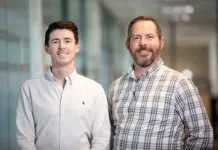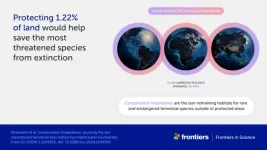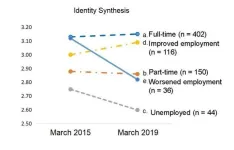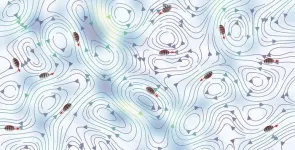(Press-News.org) A genetic variation common in people of African ancestry is associated with an increased risk of complications from diabetes, including diabetic retinopathy, according to a report published June 25 in the journal Nature Medicine.
The investigators found that the diagnosis of diabetes and treatment needed to prevent diabetes complications may be delayed in people who carry the variant, G6PDdef, because it is associated with reduced levels of HbA1c, a widely used clinical marker of blood glucose levels.
Testing for genetic variations that cause G6PD deficiency could lead to improvements in the way clinicians diagnose and treat diabetes, thereby helping to reduce the long-observed disparity in diabetes complications between individuals of European and African ancestries, the paper concluded.
The multi-institutional study was led by Vanderbilt University Medical Center (VUMC), the VA Tennessee Valley Healthcare System and Million Veteran Program (MVP) of the U.S. Department of Veterans Affairs, Emory University School of Medicine, and the Joseph Maxwell Cleland Atlanta VA Healthcare System.
“This discovery could lead to changes in the way diabetes is managed for millions of patients in the U.S. and around the world,” said Todd Edwards, PhD, MS, the paper’s co-corresponding author with Ayush Giri, PhD. Both are VUMC faculty members affiliated with the VA Tennessee Valley Healthcare System.
“More needs to be done, such as health economics and policy studies, and clinical trials, to establish the best way to use this knowledge to prevent diabetes complications,” said Edwards, associate professor of Medicine. “Now that process can begin."
More than 400 million people worldwide have G6PD deficiency. Although most MVP participants are men, millions of women are also at increased risk of diabetes complications if they carry a copy of the G6PDdef variant.
“While this discovery may impact how millions of individuals manage their diabetes, it also highlights the importance of including diverse populations in biomedical research,” said the paper’s first author, Joseph Breeyear, PhD, MS, a postdoctoral research fellow at the National Institute of Environmental Health Sciences of the National Institutes of Health (NIH).
“By including underrepresented individuals, we can identify genetic variations that affect health outcomes,” said Breeyear, who earned his PhD in Human Genetics in the Edwards lab at VUMC in 2023.
Diabetic retinopathy, damage to retinal blood vessels and nerves at the back of the eye that can cause permanent vision loss, has previously been linked to genetic variations called single nucleotide polymorphisms, or SNPs, but these associations have been studied primarily in individuals of European and Asian ancestry.
The estimated prevalence of diabetic retinopathy in the United States ranges from 24% in non-Hispanic white people to 34% in non-Hispanic Black people.
To better understand why some people with diabetes develop retinopathy but others don’t, the researchers conducted a combined-ancestry genome-wide association study (GWAS) of more than 197,000 individuals with diabetes, including more than 68,000 who also had diabetic retinopathy.
The study was the largest ancestry-stratified, SNP-based estimation of the heritability of diabetic retinopathy conducted to date and included an unprecedented number of individuals of non-Hispanic African ancestry — more than 46,000.
The researchers utilized electronic health records and genomic data from the Million Veteran Program, the United Kingdom Biobank, VUMC’s biorepository, called BioVU, the Mass General Brigham Biobank in Boston, and summary statistics from a 2019 study.
They also investigated the effect of G6PDdef on the risk of diabetes complications among participants in the NIH-sponsored Action to Control Cardiovascular Risk in Diabetes (ACCORD) clinical trial, which assessed the impact of tight diabetes control on cardiovascular events in more than 10,000 adults with Type 2 diabetes.
Their analysis found that individuals of non-Hispanic African ancestry with G6PDdef in the ACCORD trial had a significantly higher likelihood of two diabetes complications — diabetic retinopathy and diabetic nephropathy — compared to individuals without the variant, despite receiving standard-of-care treatment to lower HbA1c levels.
The current study detected nine previously unreported loci, or positions on the chromosomes, which were associated with diabetic retinopathy, including an evolutionarily adaptive genetic variant that potentially may explain some of the racial disparity in diabetes complications.
The G6PDdef variant results in deficiency of the enzyme glucose 6-phosphate dehydrogenase. Common only in African and in some Asian populations, this genetic variation may have evolved as a protection against severe malaria.
It is associated with a shorter red blood cell lifespan, which lowers HbA1c levels but not blood glucose levels. This “mismatch” can mask the true extent of hyperglycemia: in individuals who carry the G6PDdef mutation, HbA1c levels systematically underestimate blood glucose levels.
Based on the prevalence of this genetic variant, the researchers estimated that more than 250,000 men and 500,000 women of non-Hispanic African ancestry in the United States who have diabetes may have some level of G6PD deficiency.
These figures are broadly consistent with a previous study, which estimated that diabetes might be diagnosed late, or remain undiagnosed, in as many as 650,000 people of non-Hispanic African ancestry in the United States due to the G6PDdef variant.
“With comprehensive screening … and subsequent standard-of-care treatment, possibly aimed at glucose rather than HbA1c targets, nearly 12% of diabetic retinopathy cases and 9% of diabetic neuropathy cases in individuals of non-Hispanic African ancestry could be avoided in the U.S. alone,” the researchers concluded.
HbA1c works well as a marker for hyperglycemia in most people, but not as well in individuals with genetic disorders that affect enzyme function such as G6PD deficiency, noted Giri, assistant professor of Obstetrics and Gynecology at VUMC.
“Were HbA1c not used widely for screening and management of diabetes, we likely would not observe such a finding,” he said.
Eighteen research groups, including six affiliated with the VA, contributed to the study.
Co-authors from VUMC and the VA Tennessee Valley Healthcare System were Jacklyn Hellwege, PhD, Hanna Poisner, Sabrina Mitchell, PhD, Til Basnet, PhD, Alexander Bick, MD, PhD, Otis Wilson, Adriana Hung, MD, MPH, and Milam Brantley Jr., MD, PhD.
The research was supported by NIH grants F31EY033663, T32EY021453, R01EY025295, R01EY032159, P30EY026877, P30EY025885, P30EY011373, K12HD043483, R01AR074989, K12AR084232, R01DK127083, R01DK127083, K01DK120631, R01HL110380, R01HL161516, R21AI156161, U01HG011723, U01HG011723, TL1TR002244, UM1TR00406, UL1TR002378 and U18DP006711.
Grants from the VA Office of Research & Development: CSP 2002, CSP 2008, I01 CX001899, I01 CX001737, I01 BX005831, IK6 BX005233, I01 BX004557, and I01 CX001481.
Other sources of support were the Doris Duke Foundation, American Diabetes Association, Research to Prevent Blindness, and the Intramural Research Program of the National Institute of Environmental Health Sciences.
END
Gene variant may underlie diabetes disparities: study
2024-06-25
ELSE PRESS RELEASES FROM THIS DATE:
Scientists identify safe havens we must preserve to prevent ‘the sixth great extinction of life on Earth’
2024-06-25
In a groundbreaking new article, a coalition of conservationists and researchers have shown how we can protect Earth’s remaining biodiversity by conserving just a tiny percentage of the planet’s surface. This affordable, achievable plan would make it possible for us to preserve the most threatened species from extinction, safeguarding Earth’s wildlife for the future.
“Most species on Earth are rare, meaning that species either have very narrow ranges or they occur at very low densities ...
FRONTIERS opens new call for science journalism in residency program
2024-06-25
Today, the FRONTIERS Science Journalism Initiative opens the second call for applications for its science journalism in residency programme. The application period will remain open until the 25th of September 2024, at 17:00 CEST.
Funded by the European Research Council (ERC), this initiative offers science journalists the opportunity to develop independent journalism while spending three to five months in a host research institution, located in an EU Member State or a country associated with the EU’s Horizon Europe Programme. The residency ...
Beyond work: Employment affects identity in late 20-somethings
2024-06-25
Osaka, Japan — For people in their late 20s, “Your job doesn’t define you” is likely an unconvincing cliché.
Osaka Metropolitan University researchers have unveiled critical insights into the intricate relationships between employment status, identity development and life satisfaction among Japanese individuals in late emerging adulthood, or their late 20s, highlighting the importance of stable employment during this pivotal life stage.
Their findings were published in the Journal of Youth and Adolescence on May 15.
Identity reflects a sense of self and is closely ...
Model shows how plankton survive in a turbulent world
2024-06-25
How do particles move in turbulent fluids? The answer to this question can be found in a new model presented in a thesis from the University of Gothenburg. The model could help speed up the development of new drugs.
When you stir a glass of water, it is easy to think that any particles in the water will end up in chaos and move completely randomly. But this is not always the case. For example, the so-called active micro-swimmers can move through flow on their own. Navid Mousavi, a PhD student at the University of Gothenburg, has created a model including various hydrodynamic factors to study how these particles handle and even ...
Study: Teacher perceptions of chronically absent young students may add to the challenges of missing school
2024-06-25
Washington, June 25, 2024—A new study finds that early elementary school teachers report feeling less close to chronically absent students and view them less positively, even when those students do not cause trouble in the classroom. This “cooling down” in the relationship between teachers and their chronically absent students may exacerbate the academic challenges these children face.
The study—by Michael A. Gottfried and Phil H. Kim at the University of Pennsylvania, and Tina Fletcher at the ...
All-in-one method measures CO2 in concrete
2024-06-25
A new device can measure carbon dioxide captured in concrete more simply and in a third of the time of current methods. Researchers at the University of Tokyo worked with engineers in industry to create the boxlike device called the concrete thermal gravimetry and gas analyzer. The device heats concrete samples to almost 1,000 degrees Celsius, causing the CO2 within to be released so it can be measured. Compared to the current technique, which involves a time-consuming and complicated process of crushing concrete samples into powder for sampling, this new method is simpler, more accurate and user-friendly. The researchers hope it ...
Internet for billions in 100 countries with no current access and hope for transplant patients worldwide in new World Economic Forum emerging technologies report
2024-06-25
The World Economic Forum, in association with Frontiers, new Top 10 Emerging Technologies of 2024, released today (25 June), shows that among technologies emerging globally, reconfigurable intelligent surfaces (RIS) and High-Altitude Platform Systems (HAPS) have the potential to connect billions worldwide who currently have no internet access.
The report also highlights how advances in genetically engineering animal organs for use in human transplantation gives hope to the millions on waiting lists worldwide. Other technologies in the top ten that that could transform lives and societies ...
A new paradigm in photothermal therapy! DGIST developed “ultrasound-assisted photothermal therapy (ULTRA-PTT)” technology!
2024-06-25
□ Professor Jin-ho Chang’s research team from the Department of Electrical Engineering and Computer Science at DGIST (President Kun-woo Lee) developed “Ultrasound-assisted photothermal therapy (ULTRA-PTT)” technology that significantly enhances the performance of conventional photothermal therapy. This technology was developed in collaboration with Senior Researcher Hye-min Kim from the Advanced Photonics Research Institute at GIST (President Ki-chul Lim) using the team’s proprietary “ultrasound-induced optical clearing” technology.
□ Phototherapy, using light, ...
Nanowires create elite warriors to enhance T cell therapy
2024-06-25
Adoptive T-cell therapy has revolutionized medicine. A patient’s T-cells — a type of white blood cell that is part of the body’s immune system — are extracted and modified in a lab and then infused back into the body, to seek and destroy infection, or cancer cells.
Now Georgia Tech bioengineer Ankur Singh and his research team have developed a method to improve this pioneering immunotherapy.
Their solution involves using nanowires to deliver therapeutic ...
Plant-sourced nitrate proves positive to human health
2024-06-25
Plant-sourced nitrate proves positive to human health
New research from Edith Cowan University (ECU) has found that nitrate from plant sources is associated with a lower risk of mortality while nitrate from other sources such as animal-based foods, processed meat and tap water, is linked to a higher risk of mortality.
Nitrate, a compound found in vegetables, meat, and drinking water, has been the subject of debate due to its potential impact on health. Emerging evidence suggests that dietary nitrate may play a role in preventing cardiovascular disease (CVD), dementia, and ...







